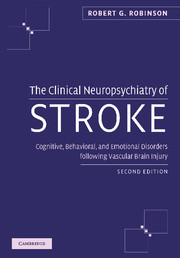 The Clinical Neuropsychiatry of Stroke
The Clinical Neuropsychiatry of Stroke Book contents
- Frontmatter
- Contents
- Preface
- Part I Introduction
- 1 Recent trends in the epidemiology of stroke
- 2 Historical perspective
- 3 Brain organization and cerebral basis of emotion
- 4 Vascular anatomy and classification of stroke
- Part II Poststroke depression
- Part III Poststroke mania
- Part IV Poststroke anxiety disorders
- Part V Other poststroke disorders
- Index
3 - Brain organization and cerebral basis of emotion
from Part I - Introduction
Published online by Cambridge University Press: 01 October 2009
- Frontmatter
- Contents
- Preface
- Part I Introduction
- 1 Recent trends in the epidemiology of stroke
- 2 Historical perspective
- 3 Brain organization and cerebral basis of emotion
- 4 Vascular anatomy and classification of stroke
- Part II Poststroke depression
- Part III Poststroke mania
- Part IV Poststroke anxiety disorders
- Part V Other poststroke disorders
- Index
Summary
As described in Chapter 2, as early as the 19th century Hughlings-Jackson (1875) recognized that symptoms associated with brain lesions may produce both loss of normal function as well as emergence of new, sometimes abnormal symptoms. These new symptoms may arise from the effect of injury on distant uninjured brain areas leading to the release of normally “inhibited” functions or the loss of normally “activated” functions. Thus, this chapter will review brain anatomy, particularly the limbic region, to help readers understand the basis of emotional disorders following brain ischemia.
Schematic drawings of the brain from lateral, coronal, and axial views are shown in Fig. 3.1. Although on initial inspection of the brain, the two hemispheres appear to be symmetrical, it has been demonstrated since the early 1800s that the human brain is functionally asymmetrical. Broca (1861) reported that disruption of language commonly occurred following left hemisphere brain injury while disturbances of language rarely resulted from right hemisphere injury. Subsequent investigations identified anatomical asymmetries associated with this lateralized language function. In a classic paper, Geschwind and Levitsky (1968) reported that the planum temporale, a structure on the dorsal surface of the temporal lobe was significantly larger in the left compared with the right hemisphere.
- Type
- Chapter
- Information
- The Clinical Neuropsychiatry of StrokeCognitive, Behavioral and Emotional Disorders following Vascular Brain Injury, pp. 17 - 26Publisher: Cambridge University PressPrint publication year: 2006


